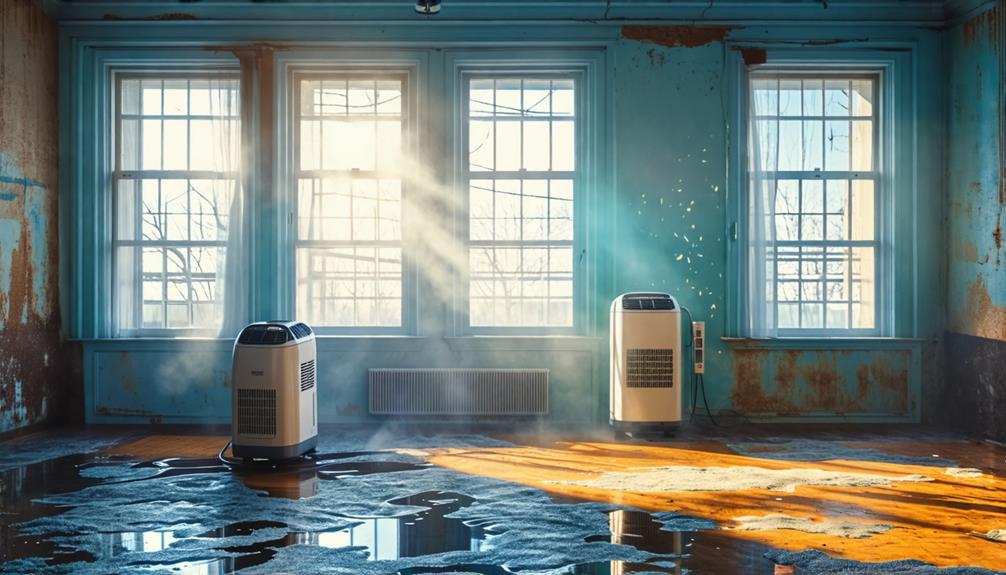Dealing with water damage after Debby requires swift action to mitigate risks, like mold growth. Start by evaluating visible and hidden areas for damage, documenting findings for insurance claims. Turn off utilities to guarantee safety and gather emergency supplies. Remove excess water using pumps or vacuums, and employ fans and dehumidifiers to dry out your home. To prevent mold, maintain humidity levels below 60%, confirm proper ventilation, and regularly inspect vulnerable spots. Engage restoration professionals for lasting repairs and maintain oversight to catch issues early. Stick around for more crucial tips on restoring your home effectively.
Key Takeaways
- Inspect all areas for visible water damage, including floors, walls, and ceilings, and document findings for insurance purposes.
- Turn off utilities immediately to prevent hazards and ensure safety during the cleanup process.
- Remove excess water using pumps or wet/dry vacuums and then measure remaining moisture with a moisture meter.
- Control humidity levels and ensure proper ventilation to prevent mold growth by using dehumidifiers and exhaust fans.
Assessing Water Damage

When you encounter water damage, the first step is to thoroughly assess the extent of the damage to determine the appropriate response. Start by inspecting visible areas like floors, walls, and ceilings for signs of water intrusion. Look for discoloration, warped surfaces, or peeling paint, which indicate moisture. Don't forget to check less obvious places, such as behind appliances or inside cabinets, where water might be lurking.
As you conduct your damage assessment, document everything with photos and notes. This will be critical for your insurance claims process later. Be detailed; include the type of damage and the affected materials. If you notice mold or structural issues, it's fundamental to highlight these as they can complicate repairs and increase health risks.
Next, assess the source of the water damage. Is it from a burst pipe, a roof leak, or flooding? Identifying the source is imperative for preventing future issues. Once you've completed this thorough evaluation, you'll have a clearer understanding of the necessary repairs and can proceed with confidence, knowing you're prepared for the next steps in addressing the water damage effectively.
Immediate Steps to Take
After evaluating the damage, your next priority is to take immediate action to mitigate further issues and begin the restoration process. Start by securing your safety; turn off the electricity and gas to prevent hazards. Then, gather your emergency kits, including gloves, masks, and towels for cleanup. Document the damage thoroughly for insurance claims; take photos and make a list of affected items.
| Action | Purpose | Notes |
|---|---|---|
| Turn Off Utilities | Prevents hazards | Guarantee safety first |
| Gather Emergency Kits | Protects against contaminants | Include gloves, masks, and towels |
| Document Damage | Supports insurance claims | Photos and itemized lists are essential |
If you've got insurance, contact your provider to report the damage and initiate your claims process. They'll guide you on what's covered and what documentation you need. By acting quickly and prudently, you'll minimize damage and streamline your recovery. Remember, the faster you address the situation, the better your chances of a successful restoration.
Drying Out Your Home

To effectively dry out your home, begin by removing excess water using pumps or wet/dry vacuums, as this will greatly reduce moisture levels and prevent further damage. After you've extracted the bulk of the water, it's essential to measure the remaining moisture in walls, floors, and furnishings. Use a moisture meter to assess the levels accurately, guiding your drying techniques.
Next, implement effective drying methods. Open windows and doors to encourage airflow, and use fans or dehumidifiers to accelerate the drying process. Position fans to direct air towards wet surfaces, ensuring efficient evaporation. If possible, raise furniture off damp carpets to promote airflow beneath them.
Consider using desiccants, such as silica gel, in small, enclosed spaces to absorb additional moisture. Monitor the progress regularly with your moisture meter, aiming for moisture levels below 20% for walls and 12% for floors.
Preventing Mold Growth
Even with effective drying methods in place, taking proactive steps to prevent mold growth is crucial to safeguarding your home from long-term damage. Mold thrives in damp environments, so managing indoor humidity is key. Here are four practical mold prevention strategies you can implement:
- Control Humidity Levels: Keep indoor humidity below 60%. Use a dehumidifier in damp areas to maintain ideal levels.
- Ventilation: Guarantee proper air circulation by using exhaust fans in bathrooms and kitchens. Open windows when weather permits to let fresh air in.
- Regular Inspections: Routinely check for leaks or damp spots in your home, particularly in basements, attics, and around windows. Address any issues immediately.
- Cleaning: Regularly clean and disinfect surfaces prone to mold growth, such as bathrooms and kitchens. Use mold-inhibiting cleaning products for added protection.
Long-Term Restoration Tips

Long-term restoration requires a systematic approach to confirm your home returns to a safe and livable condition after water damage. Start by documenting all damage thoroughly; this will support your insurance claims and guarantee you receive the necessary funds for repairs. Take photos and make detailed notes of affected areas, including furniture and personal belongings.
Next, engage restoration professionals who specialize in water damage. They'll assess the situation accurately, mitigating further issues like mold growth and structural damage. Confirm you communicate openly with these experts about your concerns and the specific needs of your home.
Once the initial cleanup is complete, focus on repairs. Replace damaged drywall, flooring, and insulation, and don't overlook the importance of proper ventilation to prevent future moisture buildup. Regularly check areas prone to dampness, such as basements and bathrooms, to catch any issues early.
Conclusion
In the aftermath of water damage, your home can feel like a shipwreck. But with prompt action and careful attention, you can restore it to its former glory. By evaluating the damage, drying out your space, and preventing mold growth, you'll not only protect your investment but create a safe haven once again. Remember, the key lies in your diligence—don't let the shadows of Debby linger; take control and breathe new life into your home.
